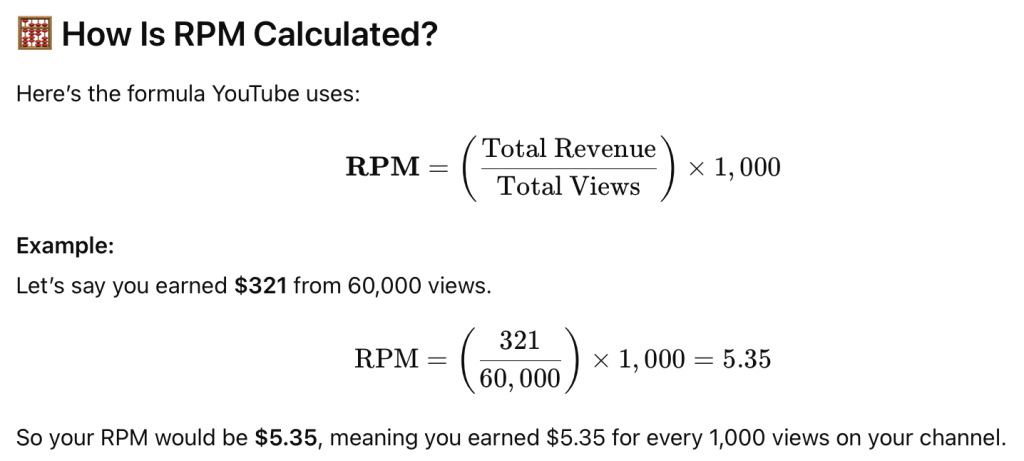If you’re a YouTube creator or just starting out, you’ve probably come across the term RPM in your analytics dashboard. But what does it really mean, and why is it important for understanding how much money you’re making from your content?
In this post, we’ll break down everything you need to know about RPM, how it’s calculated, how it differs from CPM, and what you can do to improve it.
📊 What Is RPM?
RPM stands for Revenue Per Mille, or Revenue per 1,000 views. It tells you how much money you actually earn for every 1,000 views on your channel — after YouTube takes its cut and factoring in all revenue sources.
💬 In short:
RPM = How much YOU earn (per 1,000 views) from ads, memberships, super chats, YouTube Premium, etc.

🤔 RPM vs. CPM: What’s the Difference?
Many creators confuse RPM with CPM, but they’re very different:
| Metric | Stands For | What It Measures | Who It Applies To |
|---|---|---|---|
| CPM | Cost Per Mille | How much advertisers pay per 1,000 ad impressions | Paid by advertisers |
| RPM | Revenue Per Mille | How much creators earn per 1,000 views (including all revenue streams) | Earned by you, the creator |
Key takeaway: CPM is what advertisers pay. RPM is what you take home.
💵 What Affects Your RPM?
Your RPM can fluctuate based on several factors:
- Audience location (U.S. and European viewers tend to generate higher revenue)
- Niche (Finance, tech, and business often have higher RPMs than entertainment or gaming)
- Ad types (Skippable vs. non-skippable ads)
- YouTube Premium views
- Channel monetization methods (ads, memberships, Super Chats, etc.)
🚀 How to Improve Your RPM
While RPM isn’t 100% in your control, here are a few tips to help boost it:
- Target high-RPM niches like finance, education, or business.
- Increase watch time to allow more mid-roll ads.
- Encourage viewers to become members or support via Super Chat.
- Make longer videos (8+ minutes allows more ad placements).
- Attract a global (especially U.S.-based) audience.
🔚 Final Thoughts
Understanding RPM is crucial for serious YouTube creators. It gives you a realistic picture of how your channel is performing financially and helps you make smarter decisions about your content strategy.
So next time you check your analytics, don’t just focus on views — keep an eye on that RPM number too. It’s one of the clearest indicators of how well your content is converting into revenue.
